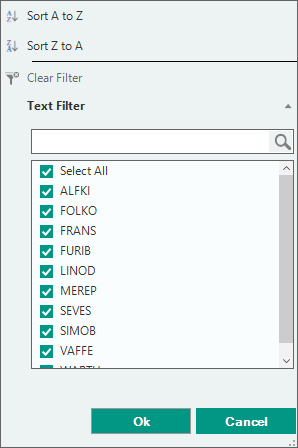Filtering with Windows Forms DataGrid
23 Apr 202424 minutes to read
Filtering is the process of retrieving the values from the collection which satisfy the specified condition. In the WinForms DataGrid (SfDataGrid) the filtering can be applied though the UI as well as the programmatic filters.
Programmatic Filtering
The programmatic filtering can be applied to the SfDataGrid by using the following methods,
- View Filtering
- Column Filtering
View Filtering
The view filtering can be applied by setting the SfDataGrid.View.Filter delegate. Once the Filter delegate is set for the view, call theRefreshFilter method to refresh the view.
Here, FilterRecords delegate is assigned to SfDataGrid.View.Filter predicate to filter CustomerID column. After that, SfDataGrid.View.RefreshFilter method is called to refresh the records. If the record satisfies the filter conditions, true will be returned. Else false is returned.
public bool FilterRecords(object o)
{
string filterText = "FRANS";
var item = o as OrderInfo;
if (item != null)
{
if (item.CustomerID.Equals(filterText))
return true;
}
return false;
}
private void btnApplyFilter_Click(object sender, EventArgs e)
{
sfDataGrid1.View.Filter = FilterRecords;
sfDataGrid1.View.RefreshFilter();
}Public Function FilterRecords(ByVal o As Object) As Boolean
Dim filterText As String = "FRANS"
Dim item = TryCast(o, OrderInfo)
If item IsNot Nothing Then
If item.CustomerID.Equals(filterText) Then
Return True
End If
End If
Return False
End Function
Private Sub btnApplyFilter_Click(ByVal sender As Object, ByVal e As EventArgs)
sfDataGrid1.View.Filter = AddressOf FilterRecords
sfDataGrid1.View.RefreshFilter()
End SubNOTE
View filters is not supported when the DataSource is DataTable.
Column Filtering
The column filtering can be achieved by adding the FilterPredicate to the GridColumn.FilterPredicates property.
// Filter the OrderID column with a value of 10005.
sfDataGrid1.Columns["OrderID"].FilterPredicates.Add(new FilterPredicate() { FilterType = FilterType.Equals, FilterValue = "10005" });' Filter the OrderID column with a value of 10005.
sfDataGrid1.Columns("OrderID").FilterPredicates.Add(New FilterPredicate() With {.FilterType = FilterType.Equals, .FilterValue = "10005"})Filter Behavior
The FilterBehavior property is used to specify whether to consider the FilterValue as the string or specific data type.
- StringTyped - Records are filtered without considering the type and it takes FilterValue type as string.
- StronglyTyped - Records are filtered by considering the FilterValue underlying type.
NOTE
When theDataTable is used as a datasource, IsCaseSensitive property in FilterPredicate is not applicable, since
DataTabledoes not support case sensitive filtering.
Clear Filtering
The Filters applied to the SfDataGrid can be removed by clearing the FilterPredicates added for the columns. This can be achieved by using the following methods,
- SfDataGrid.ClearFilters - Clears filters for all the columns programmatically.
- SfDataGrid.ClearFilter(String columnName) - Clears the filter for particular column that has the columnName as MappingName.
- SfDataGrid.ClearFilter(GridColumn column) - Clears the filter for particular column alone.
sfDataGrid1.ClearFilters();
sfDataGrid1.ClearFilter("OrderID");
sfDataGrid1.ClearFilter(sfDataGrid1.Columns[0]);sfDataGrid1.ClearFilters()
sfDataGrid1.ClearFilter("OrderID")
sfDataGrid1.ClearFilter(sfDataGrid1.Columns(0))Adding multiple FilterPredicates for a column
The PredicateType property is used to apply multiple FilterPredicates for a column.
- And: Performs And operation in filters.
- AndAlso: Performs AndAlso operation in filters.
- Or: Performs Or operation in filters.
- OrElse: Performs OrElse operation in filters.
//Filter the CustomerID column with values "FRANS" or "MEREP"
sfDataGrid.Columns["CustomerID"].FilterPredicates.Add(new FilterPredicate() { FilterType = FilterType.Equals, FilterValue = "FRANS", PredicateType = PredicateType.Or });
sfDataGrid.Columns["CustomerID"].FilterPredicates.Add(new FilterPredicate() { FilterType = FilterType.Equals, FilterValue = "MEREP", PredicateType = PredicateType.Or });'Filter the CustomerID column with values "FRANS" or "MEREP"
sfDataGrid.Columns("CustomerID").FilterPredicates.Add(New FilterPredicate() With {.FilterType = FilterType.Equals, .FilterValue = "FRANS", .PredicateType = PredicateType.Or})
sfDataGrid.Columns("CustomerID").FilterPredicates.Add(New FilterPredicate() With {.FilterType = FilterType.Equals, .FilterValue = "MEREP", .PredicateType = PredicateType.Or})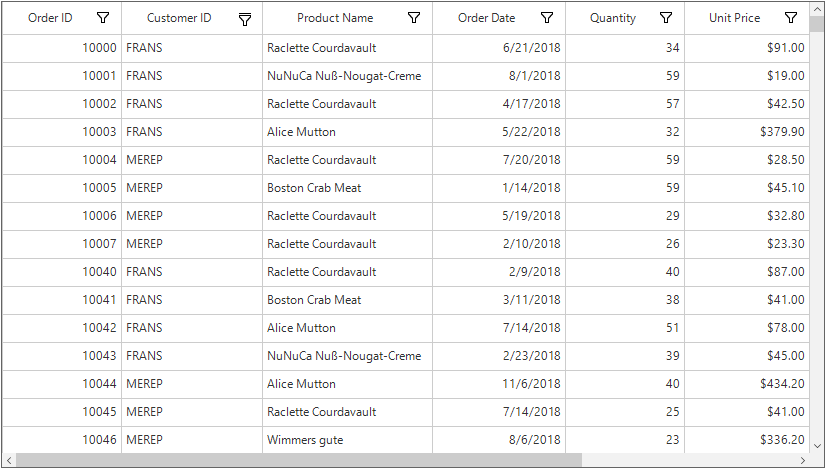
Filter DateColumn with range between two dates
A GridDateTimeColumn can be filtered with range between two dates by applying two FilterPredicates for the same column. The FilterType for the FilterPredicate with start date should be GreaterThanOrEqual and end date should be LessThanOrEqual.
//Filter the Dates between 8/1/2018 to 8/9/2018
sfDataGrid.Columns["OrderDate"].FilterPredicates.Add(new FilterPredicate() { FilterType = FilterType.GreaterThanOrEqual, FilterValue = "8/1/2018" });
sfDataGrid.Columns["OrderDate"].FilterPredicates.Add(new FilterPredicate() { FilterType = FilterType.LessThanOrEqual, FilterValue = "8/9/2018" });'Filter the Dates between 8/1/2018 to 8/9/2018
sfDataGrid.Columns("OrderDate").FilterPredicates.Add(New FilterPredicate() With {.FilterType = FilterType.GreaterThanOrEqual, .FilterValue = "8/1/2018"})
sfDataGrid.Columns("OrderDate").FilterPredicates.Add(New FilterPredicate() With {.FilterType = FilterType.LessThanOrEqual, .FilterValue = "8/9/2018"})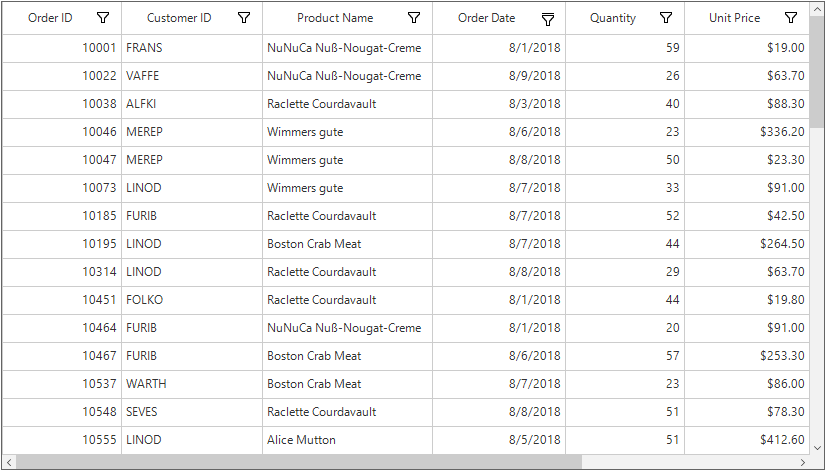
Retrieving the filtered records
After filtering, the records in the view can be retrieved in the same order as displayed in the view by using the SfDataGrid.View.Records collection.
foreach (var record in sfDataGrid.View.Records)
{
// Do your customizations here.
}For Each record In sfDataGrid.View.Records
' Do your customizations here.
Next recordUI Filtering
The WinForms DataGrid (SfDataGrid) provides excel like filtering UI and also advanced filter UI to filter the data easily. UI filtering can be enabled by setting SfDataGrid.AllowFiltering property to true. This allows to open the filter UI by clicking on the filter icon in column header to filter the records.
The filtering can be enabled or disabled for the particular column by setting GridColumn.AllowFiltering property.
// Enable the UI filtering for the SfDataGrid.
this.sfDataGrid1.AllowFiltering = true;
// Enable the UI filtering for the OrderID column.
this.sfDataGrid1.Columns["OrderID"].AllowFiltering = true;' Enable the UI filtering for the SfDataGrid.
Me.sfDataGrid1.AllowFiltering = True
' Enable the UI filtering for the OrderID column.
Me.sfDataGrid1.Columns("OrderID").AllowFiltering = TrueNOTE
GridColumn.AllowFilteringhas higher priority thanSfDataGrid.AllowFilteringproperty.
Built-in UI Views
The SfDataGrid provides the following types of Filter popup modes,
- Checkbox Filter - Provides excel like filter interface with list of check box’s.
- Advanced Filter - Provides advanced filter options to filter the data.
- Both - Both Checkbox Filter and Advanced Filter are loaded while opening the filter pop-up.
By default, the filter popup mode of the column is set asBoth. The checkbox and the advanced filter UI’s can be switched by using the Advanced Filter button.
Checkbox Filtering UI
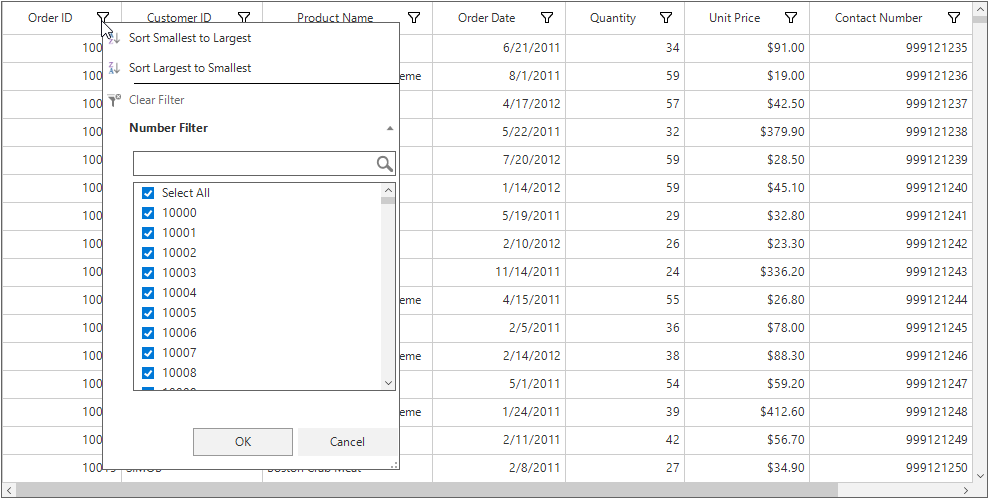
Advanced Filtering UI
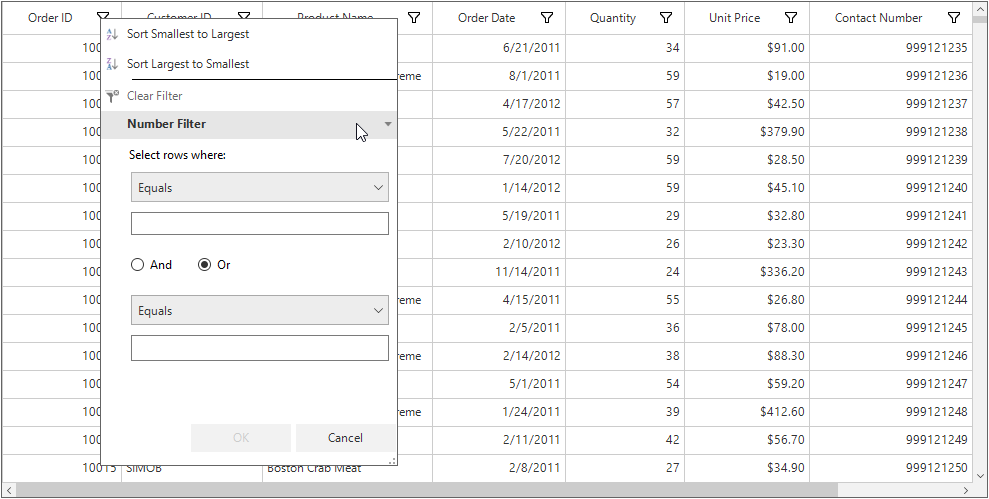
Changing Filter UI View for Grid
The Filter popup mode for the SfDataGrid can be set by using the SfDataGrid.FilterPopupMode property.
// Sets the Advanced filter mode for the SfDataGrid.
this.sfDataGrid1.FilterPopupMode = FilterPopupMode.AdvancedFilter;
// Sets the CheckBox filter mode for the SfDataGrid.
this.sfDataGrid1.FilterPopupMode = FilterPopupMode.CheckBoxFilter;
//Sets the Both filter mode for the SfDataGrid.
this.sfDataGrid1.FilterPopupMode = FilterPopupMode.Both;' Sets the Advanced filter mode for the SfDataGrid.
Me.sfDataGrid1.FilterPopupMode = FilterPopupMode.AdvancedFilter
' Sets the CheckBox filter mode for the SfDataGrid.
Me.sfDataGrid1.FilterPopupMode = FilterPopupMode.CheckBoxFilter
'Sets the Both filter mode for the SfDataGrid.
Me.sfDataGrid1.FilterPopupMode = FilterPopupMode.BothChanging Filter UI View for Column
The Filter popup mode for the column can be set by using the GridColumn.FilterPopupMode property.
// Sets the advanced filter popup mode for the column.
sfDataGrid1.Columns["OrderID"].FilterPopupMode = FilterPopupMode.AdvancedFilter;
// Sets the checkbox filter popup mode for the column.
sfDataGrid1.Columns["OrderID"].FilterPopupMode = FilterPopupMode.CheckBoxFilter;
// Sets the Both advanced and checkbox filter popup mode for the column.
sfDataGrid1.Columns["OrderID"].FilterPopupMode = FilterPopupMode.Both;' Sets the advanced filter popup mode for the column.
sfDataGrid1.Columns("OrderID").FilterPopupMode = FilterPopupMode.AdvancedFilter
' Sets the checkbox filter popup mode for the column.
sfDataGrid1.Columns("OrderID").FilterPopupMode = FilterPopupMode.CheckBoxFilter
' Sets the Both advanced and checkbox filter popup mode for the column.
sfDataGrid1.Columns("OrderID").FilterPopupMode = FilterPopupMode.BothChanging Filter UI using Event
The column FilterPopupMode can also be changed by using the FilterPopupShowing event. This even will be raised on opening the filter popup.
sfDataGrid.FilterPopupShowing += sfDataGrid_FilterPopupShowing;
void sfDataGrid_FilterPopupShowing(object sender, FilterPopupShowingEventArgs e)
{
if(e.Column.MappingName == "OrderID")
{
e.Control.FilterPopupMode = FilterPopupMode.AdvancedFilter;
}
}AddHandler sfDataGrid.FilterPopupShowing, AddressOf sfDataGrid_FilterPopupShowing
Private Sub sfDataGrid_FilterPopupShowing(ByVal sender As Object, ByVal e As FilterPopupShowingEventArgs)
If e.Column.MappingName = "OrderID" Then
e.Control.FilterPopupMode = FilterPopupMode.AdvancedFilter
End If
End SubCheckbox Filtering
The Checkbox filtering is like the Excel like filter popup. Which shows the checked list box of the unique items with the search textbox.
The items which are in the checked state will be visible in the view other items will be filtered out of the view.
// Sets the CheckBox filter mode for the SfDataGrid.
this.sfDataGrid1.FilterPopupMode = FilterPopupMode.CheckBoxFilter;
// Sets the checkbox filter popup mode for the column.
sfDataGrid1.Columns["OrderID"].FilterPopupMode = FilterPopupMode.CheckBoxFilter;' Sets the CheckBox filter mode for the SfDataGrid.
Me.sfDataGrid1.FilterPopupMode = FilterPopupMode.CheckBoxFilter
' Sets the checkbox filter popup mode for the column.
sfDataGrid1.Columns("OrderID").FilterPopupMode = FilterPopupMode.CheckBoxFilter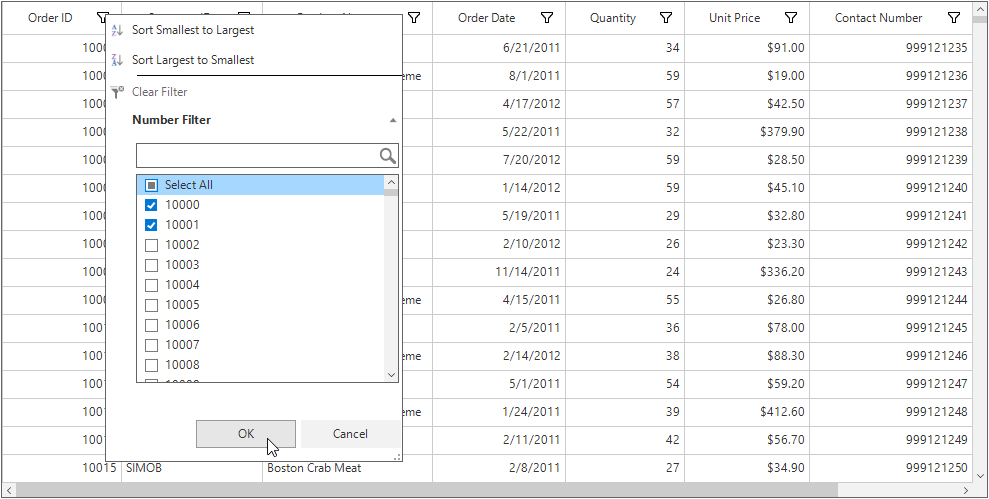
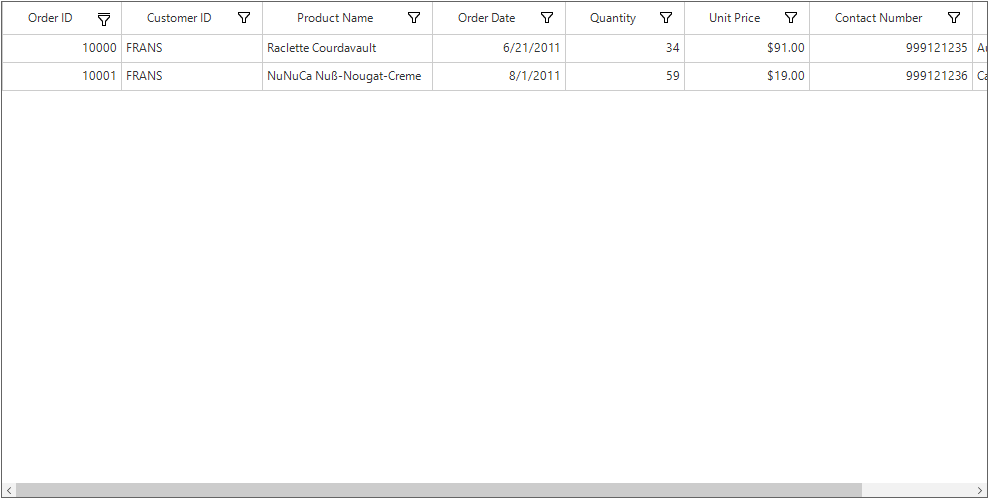
Instant Filtering
By default, filters are applied to the columns when OK button is clicked in UI filtering. This can be change to update the filters immediately whenever update in filter popup by setting the ImmediateUpdateColumnFilter property as true for the corresponding column.
This will loads the Checkbox filter popup with the Done button to close the filter popup.
// Enable immediate filtering for the column.
this.sfDataGrid1.Columns["CustomerID"].ImmediateUpdateColumnFilter = true;' Enable immediate filtering for the column.
Me.sfDataGrid1.Columns("CustomerID").ImmediateUpdateColumnFilter = True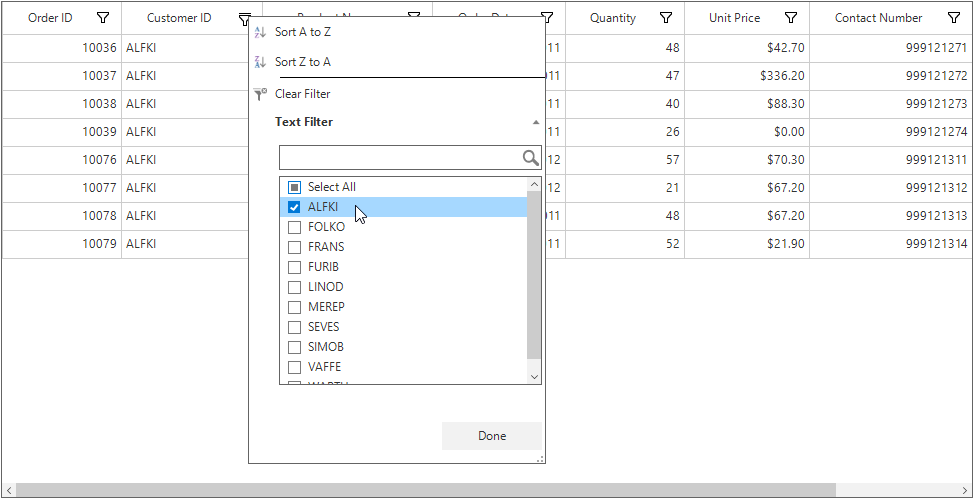
Filtering Null Values
The null values of the column can be filtered by using the ` (Blanks) ` option of the checked list box. This can be enabled for the column by setting the AllowBlankFilters property to true.
// Enable blank filters for the column.
this.sfDataGrid1.Columns["CustomerID"].AllowBlankFilters = true;' Enable blank filters for the column.
Me.sfDataGrid1.Columns("CustomerID").AllowBlankFilters = True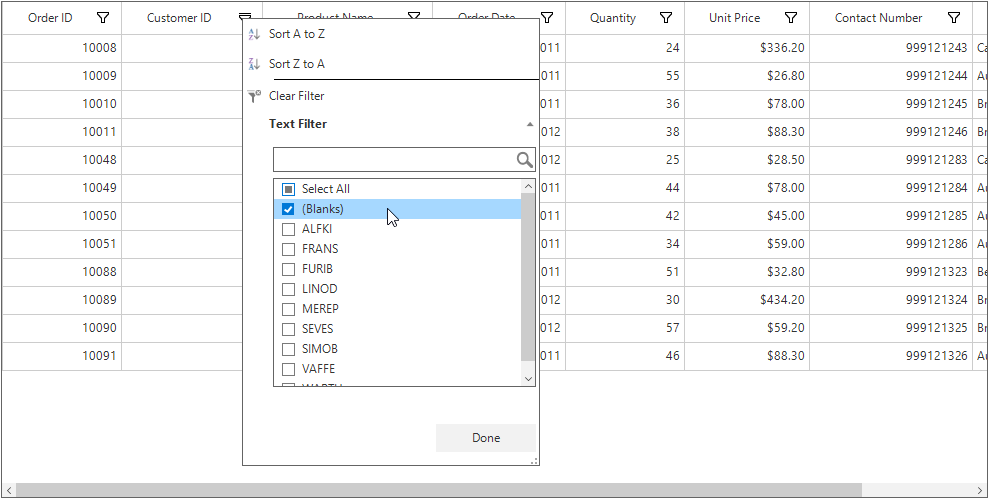
NOTE
If there is no null values exist in the column, the
(Blanks)option will not be listed in the CheckedListBox.
Filtering based on Display Text
By default, the filtering is applied based on the actual value of the column. This can be changed to filter based on the display text by setting the FilterMode value as ColumnFilter.DisplayText.
In the below screenshot, first and second records have same display value for OrderDate column but both have different actual value (E.g. 29/06/2018 12:00:00 AM and 29/06/2018 6:30:00 PM).

By default, based on the actual value only filter will be applied. So it will consider both values as different. And while opening filter popup, both values will be displayed like below.
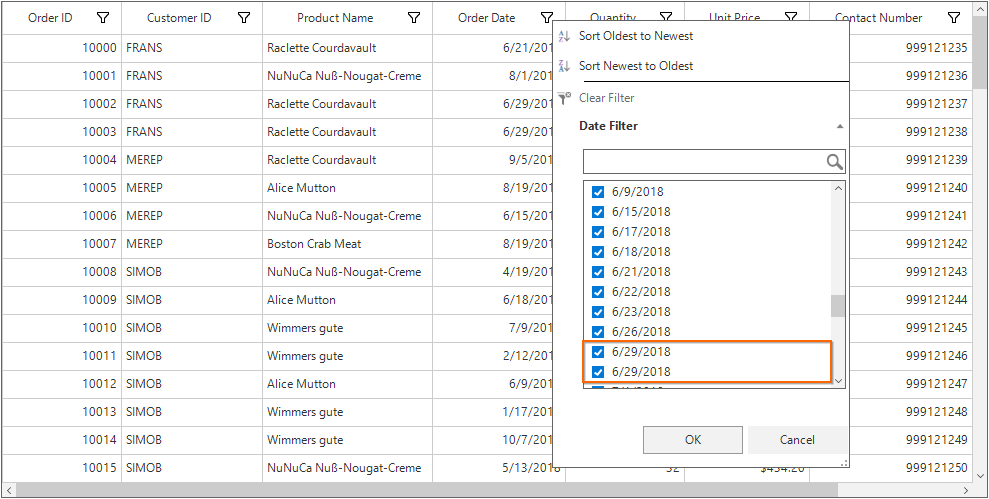
If the FilterMode is set as DisplayText, display value only will be considered for filtering. So filter popup will be shown like below.
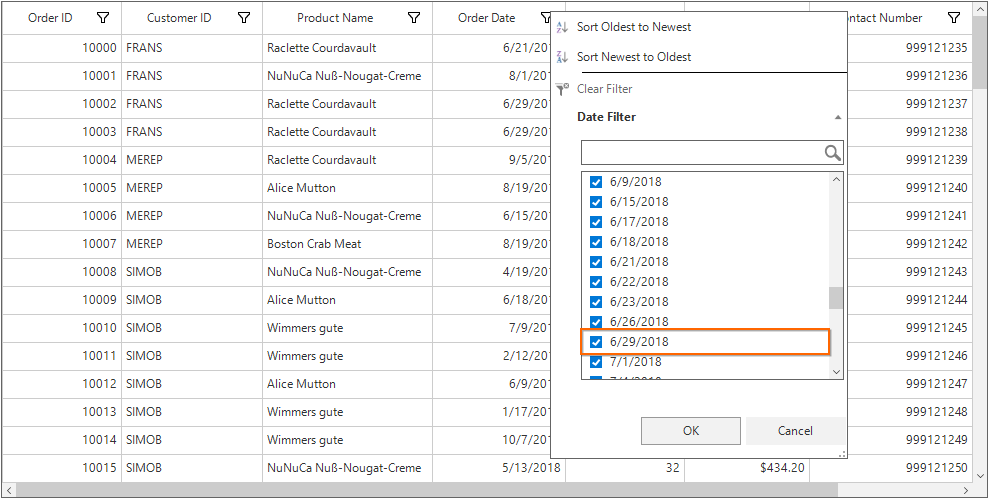
After filtering, both records having the same OrderDate display value will be displayed in view.
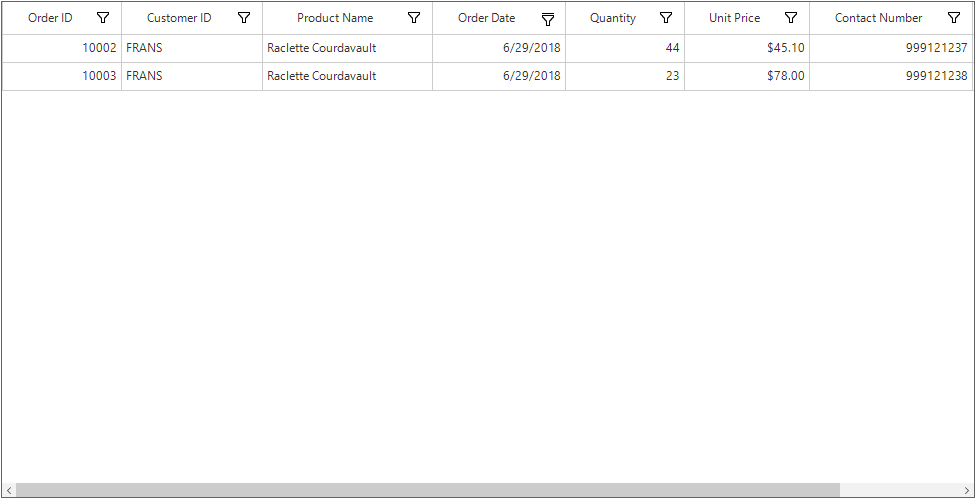
Advanced Filtering
Advanced filter UI provides multiple filter options to filter the data easily. Filter menu options are loaded based on advanced filter type by automatically detecting the underlying date type.
Below are the built-in filter types supported.
- Text Filters – Loads various menu options to filter the display text effectively.
- Number Filters – Loads various menu options to filter the numeric data.
- Date Filters – Loads various menu options and DatePicker to filter DateTime type column.
| Text Filter | Number Filter | Date Filter |
|---|---|---|
| When the string value is bounded to the GridColumn or the items source is dynamic, then `TextFilter` are loaded in advanced filter. | When integer, double, short, decimal, byte or long are bound to the GridColumn then `Number Filters` are loaded in advanced filter. | When the DateTime type value is bound to the GridColumn, then `Date Filter` is loaded in advanced filter. |
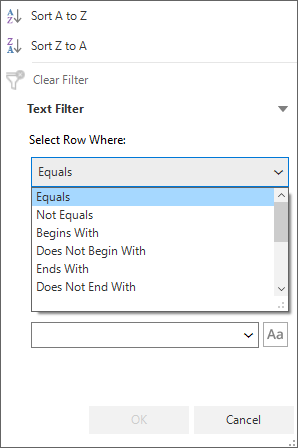
|
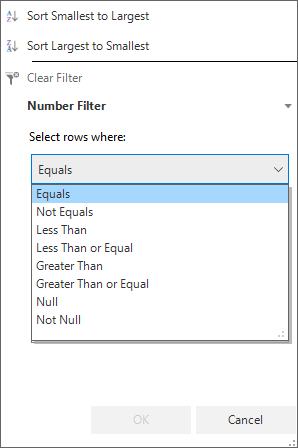
|
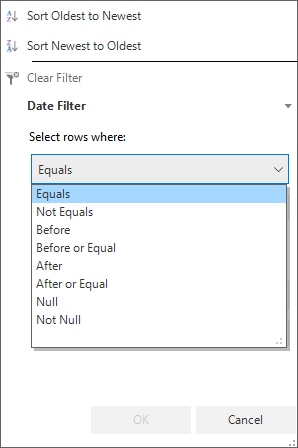
|
Filter Menu Options
|
Filter Menu Options
|
Filter Menu Options
|
NOTE
- Null and Not Null options are available only when
AllowBlankFiltersis set totrue.- If the column is
GridUnboundColumn, then Text Filter will be loaded.
Instant Filtering
By default the advanced filtering will be applied while clicking the OK button after specifying the suitable filter value. This can be changed to update filtering immediately on updating the filter popup by setting the ImmediateUpdateColumnFilter property to true for the column.

Filtering Null Values
The null values can be filtered by using the Null and Not Null filter conditions from the advanced filter.
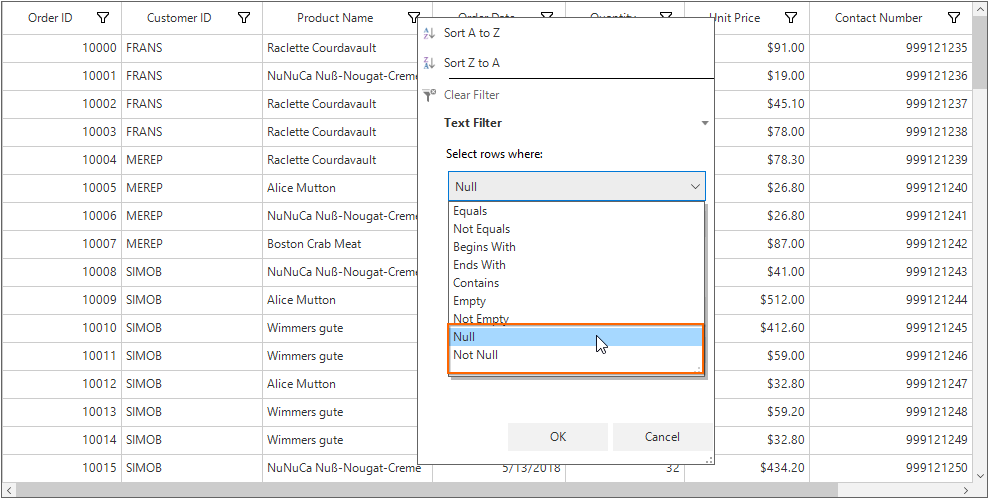
Case Sensitive Filtering
The case sensitive filtering can be enabled for the column by using the casing buttons available in the advanced filter UI. If the button is active the filtering will be applied with the case sensitive with the filter text.
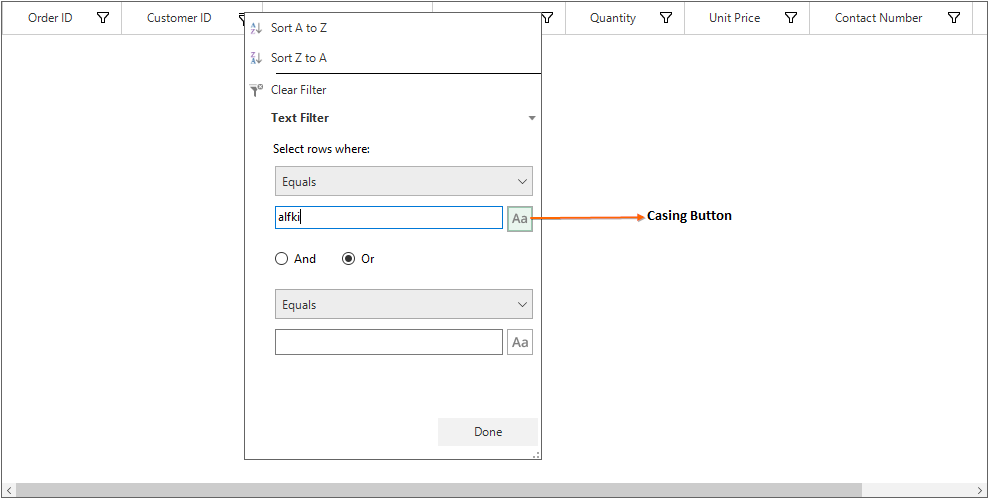
Customization using Events
Loading Text Filter for Number or Date Column
To load the Text Filter for the column that has number or date value as underlying type, set the FilterBehavior property of the GridColumn as StringTyped. This loads the Text Filters instead of Number or Date Filters.
//To load the text filter instead of date filter.
sfDataGrid.Columns["OrderDate"].FilterBehavior = FilterBehavior.StringTyped;'To load the text filter instead of date filter.
sfDataGrid.Columns("OrderDate").FilterBehavior = FilterBehavior.StringTypedCustomizing Filter Predicates
The filter predicated can be customized by using the FilterChanging event. This event will be raised while applying the filter using the filter control.
sfDataGrid.FilterChanging +=sfDataGrid_FilterChanging;
void sfDataGrid_FilterChanging(object sender, FilterChangingEventArgs e)
{
if (e.FilterPredicates == null || e.Column.MappingName != "CustomerID" || e.FilterPredicates.Count == 0)
return;
if (e.FilterPredicates[0].FilterValue.Equals("ALFKI"))
e.FilterPredicates[0].FilterValue = "MEREP";
}AddHandler sfDataGrid.FilterChanging, AddressOf sfDataGrid_FilterChanging
Private Sub sfDataGrid_FilterChanging(ByVal sender As Object, ByVal e As FilterChangingEventArgs)
If e.FilterPredicates Is Nothing OrElse e.Column.MappingName <> "CustomerID" OrElse e.FilterPredicates.Count = 0 Then
Return
End If
If e.FilterPredicates(0).FilterValue.Equals("ALFKI") Then
e.FilterPredicates(0).FilterValue = "MEREP"
End If
End SubGetting the Filtered Records
The filtered records can be get by using the FilterChanged event. This event will be fired after performing the filtering in SfDataGrid.
sfDataGrid.FilterChanged +=sfDataGrid_FilterChanged;
void sfDataGrid_FilterChanged(object sender, FilterChangedEventArgs e)
{
//OrderInfo is Model Class
ObservableCollection<OrderInfo> order = new ObservableCollection<OrderInfo>();
// Get filtered records
var records = (sender as SfDataGrid).View.Records;
foreach (RecordEntry record in records)
order.Add(record.Data as OrderInfo);
}AddHandler sfDataGrid.FilterChanged, AddressOf sfDataGrid_FilterChanged
Private Sub sfDataGrid_FilterChanged(ByVal sender As Object, ByVal e As FilterChangedEventArgs)
'OrderInfo is Model Class
Dim order As New ObservableCollection(Of OrderInfo)()
' Get filtered records
Dim records = (TryCast(sender, SfDataGrid)).View.Records
For Each record As RecordEntry In records
order.Add(TryCast(record.Data, OrderInfo))
Next record
End SubDisplaying Custom Filter Control for Filtering
The custom filter control can be loaded instead of the default filter control by handling the FilterPopupShowing event.
public class CustomFilterControl : FilterControlBase
{
SfDataGrid grid;
public string MappingName { get; set; }
public CustomFilterControl(SfDataGrid grid)
: base()
{
this.grid = grid;
this.ShowSortPanel = false;
}
protected override void OnOKButtonClicked(object sender, EventArgs e)
{
if (!string.IsNullOrEmpty(MappingName))
{
var column = grid.Columns[MappingName];
column.FilterPredicates.Clear();
foreach (var item in this.CheckListBox.CheckedItems)
{
FilterPredicate predicate = new FilterPredicate
{
FilterBehavior = Syncfusion.Data.FilterBehavior.StringTyped,
PredicateType = PredicateType.Or,
FilterMode = ColumnFilter.DisplayText,
FilterType = FilterType.Contains,
FilterValue = (item as FilterElement).DisplayText,
IsCaseSensitive = false
};
column.FilterPredicates.Add(predicate);
}
}
base.OnOKButtonClicked(sender, e);
}
}Public Class CustomFilterControl
Inherits FilterControlBase
Private grid As SfDataGrid
Public Property MappingName() As String
Public Sub New(ByVal grid As SfDataGrid)
MyBase.New()
Me.grid = grid
Me.ShowSortPanel = False
End Sub
Protected Overrides Sub OnOKButtonClicked(ByVal sender As Object, ByVal e As EventArgs)
If Not String.IsNullOrEmpty(MappingName) Then
Dim column = grid.Columns(MappingName)
column.FilterPredicates.Clear()
For Each item In Me.CheckListBox.CheckedItems
Dim predicate As FilterPredicate = New FilterPredicate With {.FilterBehavior = Syncfusion.Data.FilterBehavior.StringTyped, .PredicateType = PredicateType.Or, .FilterMode = ColumnFilter.DisplayText, .FilterType = FilterType.Contains, .FilterValue = (TryCast(item, FilterElement)).DisplayText, .IsCaseSensitive = False}
column.FilterPredicates.Add(predicate)
Next item
End If
MyBase.OnOKButtonClicked(sender, e)
End Sub
End ClassThe custom filter control can be loaded in the SfDataGrid by using the FilterPopupShowing event.
void sfDataGrid_FilterPopupShowing(object sender, FilterPopupShowingEventArgs e)
{
if (e.Column.MappingName == "CustomerID")
{
e.Cancel = true;
List<string> items = new List<string>();
items.Add(new FilterElement() { DisplayText = "MEREP" });
items.Add(new FilterElement() { DisplayText = "FOLKO" });
items.Add(new FilterElement() { DisplayText = "ALFKI" });
var customFilterControl = new CustomFilterControl(this.sfDataGrid);
customFilterControl.Show(this.sfDataGrid, e.Location);
customFilterControl.CheckListBox.DataSource = items;
customFilterControl.CheckListBox.DisplayMember = "DisplayText";
customFilterControl.MappingName = e.Column.MappingName;
}
}Private Sub sfDataGrid_FilterPopupShowing(ByVal sender As Object, ByVal e As FilterPopupShowingEventArgs)
If e.Column.MappingName = "CustomerID" Then
e.Cancel = True
Dim items As New List(Of String)()
items.Add(New FilterElement() With {.DisplayText = "MEREP"})
items.Add(New FilterElement() With {.DisplayText = "FOLKO"})
items.Add(New FilterElement() With {.DisplayText = "ALFKI"})
Dim customFilterControl = New CustomFilterControl(Me.sfDataGrid)
customFilterControl.Show(Me.sfDataGrid, e.Location)
customFilterControl.CheckListBox.DataSource = items
customFilterControl.CheckListBox.DisplayMember = "DisplayText"
customFilterControl.MappingName = e.Column.MappingName
End If
End Sub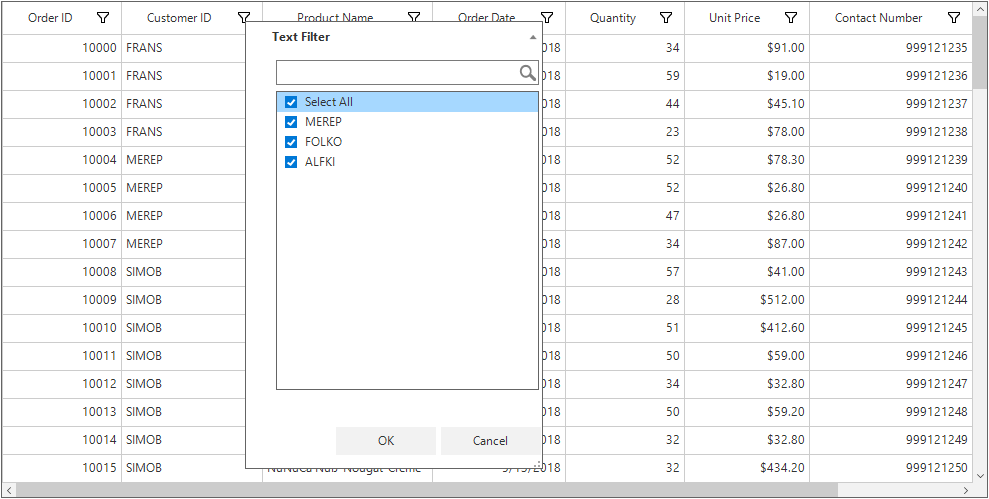
Skip the frozen row data from filtering
The frozen rows can be skipped from filtering and retained in the view by using the FilterPopupShown and FilterChanging events.
The FilterPopupShown event can be used to avoid frozen row data being populated into the filter item list.
this.sfDataGrid.FilterPopupShown += sfDataGrid_FilterPopupShown;
void sfDataGrid_FilterPopupShown(object sender, Syncfusion.WinForms.DataGrid.Events.FilterPopupShownEventArgs e)
{
//Check whether the rows frozen in SfDataGrid .
//If it is true means ,the default value loaded in FilterElement .
if (this.sfDataGrid.FrozenRowCount < 1)
return;
//Get the column name which is going to be applied Filtering
var columnName = e.Column.MappingName;
//Gets property access provider for getting frozen rows display value
var provider = this.sfDataGrid.View.GetPropertyAccessProvider();
//Get the corresponding FilterElement of the column
var dataSource = e.Control.CheckListBox.DataSource as List<FilterElement>;
//Check whether the Grouping is applied or not .
//If Grouping is not applied means ,you can get record directly from View
if (this.sfDataGrid.GroupColumnDescriptions != null && this.sfDataGrid.GroupColumnDescriptions.Count < 1)
{
//Get the records from view of SfDataGrid
var records = this.sfDataGrid.View.Records;
//Get the value for frozen rows count of corresponding column and remove it from FilterElement collection
for (int i = 0; i < this.sfDataGrid.FrozenRowCount && i < this.sfDataGrid.View.Records.Count; i++)
{
var value = provider.GetValue(records[i].Data, columnName);
if (value != null)
{
//Remove from FilterElement collection
var removeElement = dataSource.FirstOrDefault(item => (item.ActualValue != null && item.ActualValue
e.Control.CheckListBox.View.Items.Remove(removeElement);
}
}
}
//If Grouping is applied, need to get the records DisplayElements of TopLevelGroup in view
else
{
//Gets the records from DisplayElements
var records = this.sfDataGrid.View.TopLevelGroup.DisplayElements;
for (int i = 0; i < this.sfDataGrid.FrozenRowCount && i < this.sfDataGrid.View.TopLevelGroup.DisplayElemen
{
if (records[i] is RecordEntry)
{
//Get the value for frozen rows count of corresponding column and remove it
var value = provider.GetValue((records[i] as RecordEntry).Data, columnName);
if (value != null)
{
//Remove from FilterElement collection
var removeElement = dataSource.FirstOrDefault(item => (item.ActualValue != null && item.Actual
e.Control.CheckListBox.View.Items.Remove(removeElement);
}
}
}
}
}AddHandler Me.sfDataGrid.FilterPopupShown, AddressOf sfDataGrid_FilterPopupShown
Private Sub sfDataGrid_FilterPopupShown(ByVal sender As Object, ByVal e As Syncfusion.WinForms.DataGrid.Events.FilterPopupShownEventArgs)
'Check whether the rows frozen in SfDataGrid .
'If it is true means, the default value loaded in FilterElement.
If Me.sfDataGrid.FrozenRowCount < 1 Then
Return
End If
'Get the column name which is going to be applied Filtering
Dim columnName = e.Column.MappingName
'Gets property access provider for getting frozen rows display value
Dim provider = Me.sfDataGrid.View.GetPropertyAccessProvider()
'Get the corresponding FilterElement of the column
Dim dataSource = TryCast(e.Control.CheckListBox.DataSource, List(Of FilterElement))
'Check whether the Grouping is applied or not.
'If Grouping is not applied means, you can get record directly from View
If Me.sfDataGrid.GroupColumnDescriptions IsNot Nothing AndAlso Me.sfDataGrid.GroupColumnDescriptions.Count < 1 Then
'Get the records from view of SfDataGrid
Dim records = Me.sfDataGrid.View.Records
'Get the value for frozen rows count of corresponding column and remove it from FilterElement collection
Dim i As Integer = 0
Do While i < Me.sfDataGrid.FrozenRowCount AndAlso i < Me.sfDataGrid.View.Records.Count
Dim value = provider.GetValue(records(i).Data, columnName)
If value IsNot Nothing Then
'Remove from FilterElement collection
Dim removeElement = dataSource.FirstOrDefault(Function(item) (item.ActualValue IsNot Nothing AndAlso item.ActualValue.Equals(value)) OrElse item.ActualValue Is Nothing)
e.Control.CheckListBox.View.Items.Remove(removeElement)
End If
i += 1
Loop
'If Grouping is applied, need to get the records DisplayElements of TopLevelGroup in view
Else
'Gets the records from DisplayElements
Dim records = Me.sfDataGrid.View.TopLevelGroup.DisplayElements
Dim i As Integer = 0
Do While i < Me.sfDataGrid.FrozenRowCount AndAlso i < Me.sfDataGrid.View.TopLevelGroup.DisplayElements.Count
If TypeOf records(i) Is RecordEntry Then
'Get the value for frozen rows count of corresponding column and remove it from FilterElement collection
Dim value = provider.GetValue((TryCast(records(i), RecordEntry)).Data, columnName)
If value IsNot Nothing Then
'Remove from FilterElement collection
Dim removeElement = dataSource.FirstOrDefault(Function(item) (item.ActualValue IsNot Nothing AndAlso item.ActualValue.Equals(value)) OrElse item.ActualValue Is Nothing)
e.Control.CheckListBox.View.Items.Remove(removeElement)
End If
End If
i += 1
Loop
End If
End Sub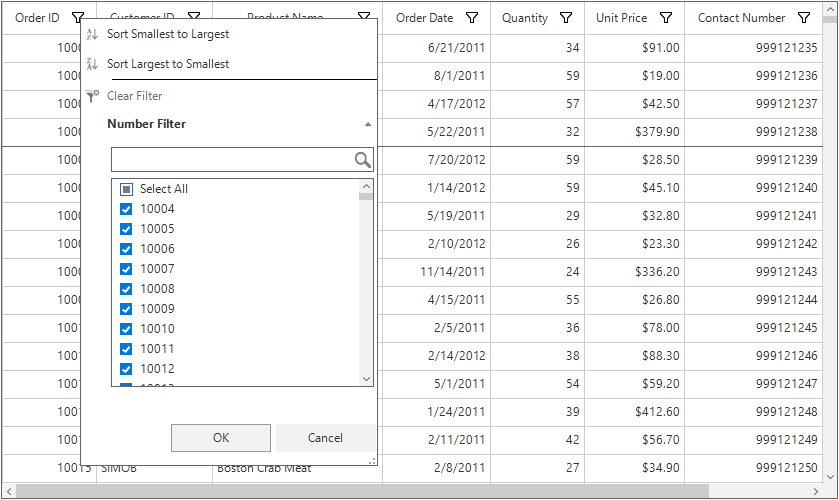
Retain the frozen row data in the view by managing the FilterPredicates collection in the FilterChanging event. In the following code, the frozen row data is added to the filter predicates using the FilterPredicates argument.
this.sfDataGrid.FilterChanging += sfDataGrid_FilterChanging;
void sfDataGrid_FilterChanging(object sender, Syncfusion.WinForms.DataGrid.Events.FilterChangingEventArgs e)
{
//Check whether the Filtering is applied and the FrozenRowCount is more than zero
//If it is true means, the default filtering operation will be performed
if (e.FilterPredicates == null || this.sfDataGrid.FrozenRowCount < 1)
return;
//Gets property access provider for getting frozen rows display value
var provider = this.sfDataGrid.View.GetPropertyAccessProvider();
//Get the column name for which the filtering is going to be applied
var columnName = e.Column.MappingName;
//Check whether the Grouping is applied or not .
//If Grouping is not applied means ,you can get record directly from View
if (this.sfDataGrid.GroupColumnDescriptions != null && this.sfDataGrid.GroupColumnDescriptions.Count < 1)
{
//Gets the records from the View
var records = this.sfDataGrid.View.Records;
//Add the FrozenRows filter predicate to view
for (int i = 0; i < this.sfDataGrid.FrozenRowCount; i++)
{
var value = provider.GetValue(records[i].Data, columnName);
AddPredicates(e.FilterPredicates, FilterType.Equals, PredicateType.Or, value);
}
}
//If Grouping is applied, need to get the records DisplayElements of TopLevelGroup in view
else
{
//Gets the records from DisplayElements
var records = this.sfDataGrid.View.TopLevelGroup.DisplayElements;
//Get the value for frozen rows count of corresponding column and add it to FilterPredicate collection
for (int i = 0; i < this.sfDataGrid.FrozenRowCount; i++)
{
if (records[i] is RecordEntry)
{
var value = provider.GetValue((records[i] as RecordEntry).Data, columnName);
AddPredicates(e.FilterPredicates, FilterType.Equals, PredicateType.Or, value);
}
}
}
}
//FilerPredicate added here
private void AddPredicates(List<FilterPredicate> FilterPredicates, FilterType FilterType, PredicateType predicateType, object value)
{
FilterPredicates.Add(new FilterPredicate()
{
FilterValue = value,
FilterType = FilterType,
FilterBehavior = FilterBehavior.StronglyTyped,
IsCaseSensitive = true,
PredicateType = predicateType
});
}AddHandler Me.sfDataGrid.FilterChanging, AddressOf sfDataGrid_FilterChanging
Private Sub sfDataGrid_FilterChanging(ByVal sender As Object, ByVal e As Syncfusion.WinForms.DataGrid.Events.FilterChangingEventArgs)
'Check whether the Filtering is applied and the FrozenRowCount is more than zero
'If it is true means, the default filtering operation will be performed
If e.FilterPredicates Is Nothing OrElse Me.sfDataGrid.FrozenRowCount < 1 Then
Return
End If
'Gets property access provider for getting frozen rows display value
Dim provider = Me.sfDataGrid.View.GetPropertyAccessProvider()
'Get the column name for which the filtering is going to be applied
Dim columnName = e.Column.MappingName
'Check whether the Grouping is applied or not .
'If Grouping is not applied means ,you can get record directly from View
If Me.sfDataGrid.GroupColumnDescriptions IsNot Nothing AndAlso Me.sfDataGrid.GroupColumnDescriptions.Count < 1 Then
'Gets the records from the View
Dim records = Me.sfDataGrid.View.Records
'Add the FrozenRows filter predicate to view
For i As Integer = 0 To Me.sfDataGrid.FrozenRowCount - 1
Dim value = provider.GetValue(records(i).Data, columnName)
AddPredicates(e.FilterPredicates, FilterType.Equals, PredicateType.Or, value)
Next i
'If Grouping is applied, need to get the records DisplayElements of TopLevelGroup in view
Else
'Gets the records from DisplayElements
Dim records = Me.sfDataGrid.View.TopLevelGroup.DisplayElements
'Get the value for frozen rows count of corresponding column and add it to FilterPredicate collection
For i As Integer = 0 To Me.sfDataGrid.FrozenRowCount - 1
If TypeOf records(i) Is RecordEntry Then
Dim value = provider.GetValue((TryCast(records(i), RecordEntry)).Data, columnName)
AddPredicates(e.FilterPredicates, FilterType.Equals, PredicateType.Or, value)
End If
Next i
End If
End Sub
'FilerPredicate added here
Private Sub AddPredicates(ByVal FilterPredicates As List(Of FilterPredicate), ByVal FilterType As FilterType, ByVal predicateType As PredicateType, ByVal value As Object)
FilterPredicates.Add(New FilterPredicate() With {.FilterValue = value, .FilterType = FilterType, .FilterBehavior = FilterBehavior.StronglyTyped, .IsCaseSensitive = True, .PredicateType = predicateType})
End Sub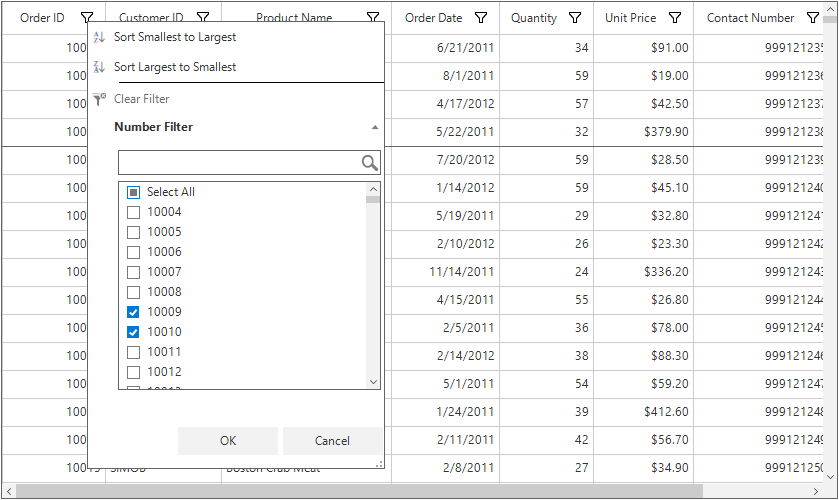
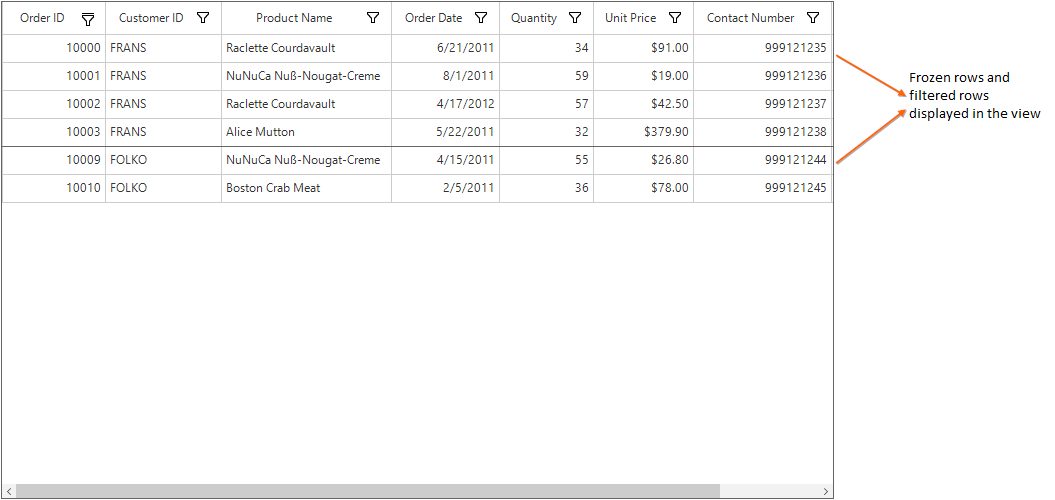
Download Sample location.
Appearance
Hiding Sort Options
The sort options of the filter control can be hidden by setting the ShowSortPanel property to false in the FilterPopupShowing event.
sfDataGrid.FilterPopupShowing +=sfDataGrid_FilterPopupShowing;
void sfDataGrid_FilterPopupShowing(object sender, FilterPopupShowingEventArgs e)
{
//Hide the sorting options of the filter control
e.Control.ShowSortPanel = false;
}AddHandler sfDataGrid.FilterPopupShowing, AddressOf sfDataGrid_FilterPopupShowing
Private Sub sfDataGrid_FilterPopupShowing(ByVal sender As Object, ByVal e As FilterPopupShowingEventArgs)
'Hide the sorting options of the filter control
e.Control.ShowSortPanel = False
End Sub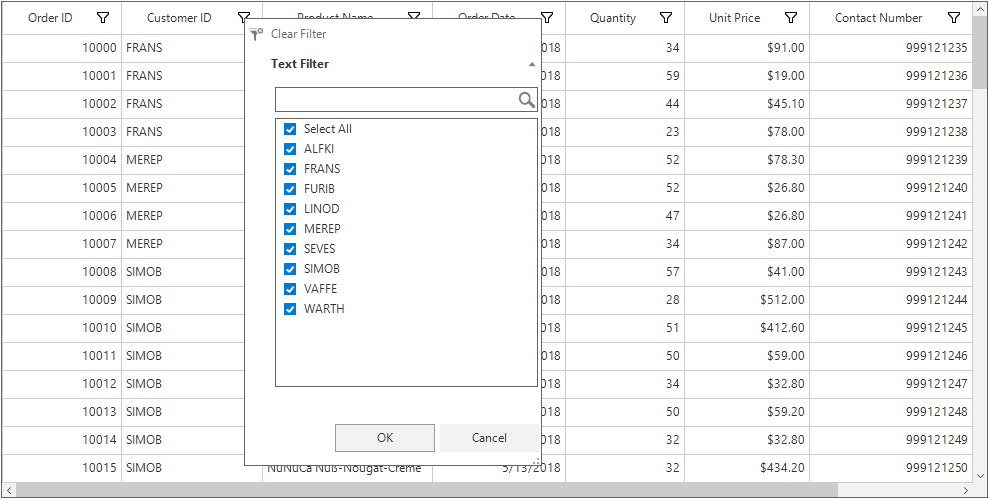
Setting Custom Filter/Filtered Icons in Column Header
The custom filter icon or the filtered icons can be set to the column header by using the HeaderStyle.FilterIcon and HeaderStyle.FilteredIcon property.
sfDataGrid.Columns[1].HeaderStyle.FilterIcon = new Bitmap(Image.FromFile(@"..\..\FilterIcon.png"));
sfDataGrid.Columns[0].HeaderStyle.FilteredIcon = new Bitmap(Image.FromFile(@"..\..\FilteredIcon.png"));sfDataGrid.Columns(1).HeaderStyle.FilterIcon = New Bitmap(Image.FromFile("..\..\FilterIcon.png"))
sfDataGrid.Columns(0).HeaderStyle.FilteredIcon = New Bitmap(Image.FromFile("..\..\FilteredIcon.png"))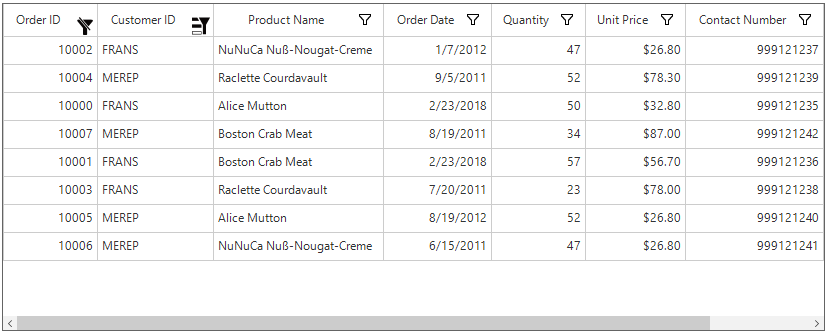
Styling filter control
The appearance of the inner controls added to the GridFilterControl can be customized using the SfDataGrid.FilterPopupShowing event. The FilterPopupShowingEventArgs.Control property provides access to all the controls inside the GridFilterControl that can be used to customize the style of each control.
this.sfDataGrid.FilterPopupShowing += sfDataGrid_FilterPopupShowing;
void sfDataGrid_FilterPopupShowing(object sender, FilterPopupShowingEventArgs e)
{
e.Control.BackColor = ColorTranslator.FromHtml("#EDF3F3");
//Customize the appearance of the CheckedListBox
e.Control.CheckListBox.Style.CheckBoxStyle.CheckedBorderColor = e.Control.CheckListBox.Style.CheckBoxStyle.CheckedBackColor = ColorTranslator.FromHtml("#029684");
e.Control.CheckListBox.Style.CheckBoxStyle.UncheckedBorderColor = ColorTranslator.FromHtml("#029684");
e.Control.CheckListBox.Style.CheckBoxStyle.IndeterminateColor = e.Control.CheckListBox.Style.CheckBoxStyle.IndeterminateBorderColor = ColorTranslator.FromHtml("#029684");
e.Control.CheckListBox.Style.ItemStyle.BackColor = ColorTranslator.FromHtml("#F9FDFE");
e.Control.CheckListBox.Style.SelectionStyle.SelectionBackColor = ColorTranslator.FromHtml("#EDF3F3");
//Customize the appearance of the Ok and Cancel buttons
e.Control.OkButton.BackColor = e.Control.CancelButton.BackColor = ColorTranslator.FromHtml("#029684");
e.Control.OkButton.ForeColor = e.Control.CancelButton.ForeColor = Color.White;
e.Control.OkButton.Font = e.Control.CancelButton.Font = new Font("Segoe UI", 9, FontStyle.Bold);
}AddHandler sfDataGrid.FilterPopupShowing, AddressOf sfDataGrid_FilterPopupShowing
Private Sub sfDataGrid_FilterPopupShowing(ByVal sender As Object, ByVal e As FilterPopupShowingEventArgs)
e.Control.BackColor = ColorTranslator.FromHtml("#EDF3F3")
'Customize the appearance of the CheckedListBox
e.Control.CheckListBox.Style.CheckBoxStyle.CheckedBackColor = ColorTranslator.FromHtml("#029684")
e.Control.CheckListBox.Style.CheckBoxStyle.CheckedBorderColor = e.Control.CheckListBox.Style.CheckBoxStyle.CheckedBackColor
e.Control.CheckListBox.Style.CheckBoxStyle.UncheckedBorderColor = ColorTranslator.FromHtml("#029684")
e.Control.CheckListBox.Style.CheckBoxStyle.IndeterminateBorderColor = ColorTranslator.FromHtml("#029684")
e.Control.CheckListBox.Style.CheckBoxStyle.IndeterminateColor = e.Control.CheckListBox.Style.CheckBoxStyle.IndeterminateBorderColor
e.Control.CheckListBox.Style.ItemStyle.BackColor = ColorTranslator.FromHtml("#F9FDFE")
e.Control.CheckListBox.Style.SelectionStyle.SelectionBackColor = ColorTranslator.FromHtml("#EDF3F3")
'Customize the appearance of the Ok and Cancel buttons
e.Control.CancelButton.BackColor = ColorTranslator.FromHtml("#029684")
e.Control.OkButton.BackColor = e.Control.CancelButton.BackColor
e.Control.CancelButton.ForeColor = Color.White
e.Control.OkButton.ForeColor = e.Control.CancelButton.ForeColor
e.Control.CancelButton.Font = New Font("Segoe UI", 9, FontStyle.Bold)
e.Control.OkButton.Font = e.Control.CancelButton.Font
End Sub